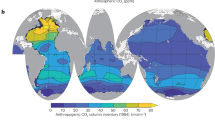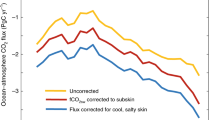Abstract
The ocean has absorbed 41 per cent of all anthropogenic carbon emitted as a result of fossil fuel burning and cement manufacture1,2. The magnitude and the large-scale distribution of the ocean carbon sink is well quantified for recent decades3,4. In contrast, temporal changes in the oceanic carbon sink remain poorly understood5,6,7. It has proved difficult to distinguish between air-to-sea carbon flux trends that are due to anthropogenic climate change and those due to internal climate variability5,6,8,9,10,11,12,13. Here we use a modelling approach that allows for this separation14, revealing how the ocean carbon sink may be expected to change throughout this century in different oceanic regions. Our findings suggest that, owing to large internal climate variability, it is unlikely that changes in the rate of anthropogenic carbon uptake can be directly observed in most oceanic regions at present, but that this may become possible between 2020 and 2050 in some regions.
This is a preview of subscription content, access via your institution
Access options
Subscribe to this journal
Receive 51 print issues and online access
$199.00 per year
only $3.90 per issue
Buy this article
- Purchase on Springer Link
- Instant access to full article PDF
Prices may be subject to local taxes which are calculated during checkout



Similar content being viewed by others
References
Khatiwala, S., Primeau, F. & Hall, T. Reconstruction of the history of anthropogenic CO2 concentrations in the ocean. Nature 462, 346–349 (2009)
Ciais, P. & Sabine, C. in Climate Change. The Physical Science Basis. Contribution of Working Group I to the Fifth Assessment Report of the Intergovernmental Panel on Climate Change (eds Stocker, T. F. et al.) Ch. 6, 1535 (Cambridge Univ. Press, 2013)
Gruber, N. et al. Oceanic sources, sinks, and transport of atmospheric CO2. Glob. Biogeochem. Cycles 23, GB1005 (2009)
Takahashi, T. et al. Climatological mean and decadal change in surface ocean pCO2, and net sea–air CO2 flux over the global oceans. Deep Sea Res. Part II 56, 554–577 (2009)
Landschützer, P. et al. The reinvigoration of the Southern Ocean carbon sink. Science 349, 1221–1224 (2015)
Schuster, U. et al. An assessment of the Atlantic and Arctic sea–air CO2 fluxes, 1990–2009. Biogeosciences 10, 607–627 (2013)
Randerson, J. T. et al. Multicentury changes in ocean and land contributions to the climate-carbon feedback. Glob. Biogeochem. Cycles 29, 744–759 (2015)
Munro, D. R. et al. Recent evidence for a strengthening CO2 sink in the Southern Ocean from carbonate system measurements in the Drake Passage (2002–2015). Geophys. Res. Lett. 42, 7623–7630 (2015)
Bates, N. et al. A time-series view of changing ocean chemistry due to ocean uptake of anthropogenic CO2 and ocean acidification. Oceanography 27, 126–141 (2014)
Fay, A. R. & McKinley, G. A. Global trends in surface ocean pCO2 from in situ data. Glob. Biogeochem. Cycles 27, 541–557 (2013)
McKinley, G. A., Fay, A. R., Takahashi, T. & Metzl, N. Convergence of atmospheric and North Atlantic carbon dioxide trends on multidecadal timescales. Nature Geosci . 4, 606–610 (2011)
Le Quéré, C., Raupach, M. R., Canadell, J. G. & Al, G. M. E. Trends in the sources and sinks of carbon dioxide. Nature Geosci . 2, 831–836 (2009)
Le Quéré, C., Takahashi, T., Buitenhuis, E. T., Rödenbeck, C. & Sutherland, S. C. Impact of climate change and variability on the global oceanic sink of CO2. Glob. Biogeochem. Cycles 24, GB4007 (2010)
Deser, C., Phillips, A., Bourdette, V. & Teng, H. Uncertainty in climate change projections: the role of internal variability. Clim. Dyn. 38, 527–546 (2012)
DeVries, T. The oceanic anthropogenic CO2 sink: storage, air-sea fluxes, and transports over the industrial era. Glob. Biogeochem. Cycles 28, 631–647 (2014)
Sarmiento, J. L. & LeQuéré, C. Oceanic carbon dioxide uptake in a model of century-scale global warming. Science 274, 1346–1350 (1996)
Deser, C., Knutti, R., Solomon, S. & Phillips, A. S. Communication of the role of natural variability in future North American climate. Nature Clim. Change 2, 775–779 (2012)
Frölicher, T. L., Joos, F., Plattner, G.-K., Steinacher, M. & Doney, S. C. Natural variability and anthropogenic trends in oceanic oxygen in a coupled carbon cycle-climate model ensemble. Glob. Biogeochem. Cycles 23, GB1003 (2009)
Ullman, D. J., McKinley, G. A., Bennington, V. & Dutkiewicz, S. Trends in the North Atlantic carbon sink: 1992–2006. Glob. Biogeochem. Cycles 23, GB4011 (2009)
Lovenduski, N. & Gruber, N. Toward a mechanistic understanding of the decadal trends in the Southern Ocean carbon sink. Glob. Biogeochem. Cycles 22, GB3016 (2008)
Long, M. C., Lindsay, K., Peacock, S., Moore, J. K. & Doney, S. C. Twentieth-century oceanic carbon uptake and storage in CESM1 (BGC). J. Clim. 26, 6775–6800 (2013)
Resplandy, L., Séférian, R. & Bopp, L. Natural variability of CO2 and O2 fluxes: what can we learn from centuries-long climate models simulations? J. Geophys. Res. 120, 384–404 (2015)
Frölicher, T. L. et al. Dominance of the Southern Ocean in anthropogenic carbon and heat uptake in CMIP5 models. J. Clim. 28, 862–886 (2015)
Hawkins, E. & Sutton, R. The potential to narrow uncertainty in regional climate predictions. Bull. Am. Meteorol. Soc. 90, 1095–1107 (2009)
Kay, J. E. et al. The Community Earth System Model (CESM) Large Ensemble Project: a community resource for studying climate change in the presence of internal climate variability. Bull. Am. Meteorol. Soc. 96, 1333–1349 (2014)
Rodgers, K. B., Lin, J. & Frolicher, T. L. Emergence of multiple ocean ecosystem drivers in a large ensemble suite with an Earth system model. Biogeosciences 12, 3301–3320 (2015)
Lovenduski, N. S., Fay, A. R. & McKinley, G. A. Observing multi-decadal trends in Southern Ocean CO2 uptake: what can we learn from an ocean model? Glob. Biogeochem. Cycles 29, 416–426 (2015)
Landschützer, P., Gruber, N., Bakker, D. C. E. & Schuster, U. Recent variability of the global ocean carbon sink. Glob. Biogeochem. Cycles 28, 927–949 (2014)
Hawkins, E. & Sutton, R. Time of emergence of climate signals. Geophys. Res. Lett. 39, L01702 (2012)
Hurrell, J. W. et al. The community earth system model: a framework for collaborative research. Bull. Am. Meteorol. Soc. 94, 1339–1360 (2013)
Moore, J. K. et al. Marine ecosystem dynamics and biogeochemical cycling in the Community Earth System Model [CESM1 (BGC)]: comparison of the 1990s with the 2090s under the RCP4.5 and RCP8.5 scenarios. J. Clim. 26, 9291–9312 (2013)
Danabasoglu, G. S. C. et al. The CCSM4 Ocean Component. J. Clim. 25, 1361–1389 (2012)
Bakker, D. C. E. et al. An update to the surface ocean CO2 atlas (SOCAT version 2). Earth Syst. Sci. Data 6, 69–90 (2014)
Fay, A. R. & McKinley, G. A. Global open-ocean biomes: mean and temporal variability. Earth Syst. Sci. Data 6, 273–284 (2014)
Fay, A. R., McKinley, G. A. & Lovenduski, N. S. Southern Ocean carbon trends: sensitivity to methods. Geophys. Res. Lett. 41, 6833–6840 (2014)
Taylor, K. E., Stouffer, R. J. & Meehl, G. A. An overview of CMIP5 and the experiment design. Bull. Am. Meteorol. Soc. 93, 485–498 (2012)
Chylek, P., Li, J., Dubey, M. K., Wang, M. & Lesins, G. Observed and model simulated 20th century Arctic temperature variability: Canadian Earth System Model CanESM2. Atmos. Chem. Phys. Discuss . 11, 22893–22907 (2011)
Collins, W. J. et al. Development and evaluation of an Earth-system model—HadGEM2. Geosci. Model Dev. 4, 1051–1075 (2011)
Dufresne, J.-L. et al. Climate change projections using the IPSL-CM5 Earth System Model: from CMIP3 to CMIP5. Clim. Dyn. 40, 2123–2165 (2013)
Dunne, J. P. et al. GFDL’s ESM2 global coupled climate-carbon Earth System Models. Part I: physical formulation and baseline simulation characteristics. J. Clim. 25, 6646–6665 (2012)
Fogli, P. G. et al. INGV-CMCC carbon (ICC): a carbon cycle earth system model. CMCC Res. Pap. 61, http://ssrn.com/abstract=1517282 (Social Science Research Network, 2009)
Giorgetta, M. et al. CMIP5 simulations of the Max Planck Institute for Meteorology (MPI-M) based on the MPI-ESM-LR model: the historical experiment. http://dx.doi.org/10.1594/WDCC/CMIP5.MXELhi (World Data Centre for Climate, Earth System Grid Federation, 2012)
Giorgetta, M. et al. CMIP5 simulations of the Max Planck Institute for Meteorology (MPI-M) based on the MPI-ESM-LR model: the RCP85 experiment. http://dx.doi.org/10.1594/WDCC/CMIP5.MXELr8 (World Data Centre for Climate, Earth System Grid Federation, 2012)
Ji, D. et al. Description and basic evaluation of Beijing Normal University Earth System Model (BNU-ESM) version 1. Geosci. Model Dev . 7, 2039–2064 (2014)
Lindsay, K. et al. Preindustrial-control and twentieth-century carbon cycle experiments with the Earth System Model CESM1 (BGC). J. Clim. 27, 8981–9005 (2014)
Tjiputra, J. F. et al. Evaluation of the carbon cycle components in the Norwegian Earth System Model (NorESM). Geosci. Model Dev . 6, 301–325 (2013)
Volodin, E. M., Dianskii, N. A. & Gusev, A. V. Simulating present-day climate with the INMCM4.0 coupled model of the atmospheric and oceanic general circulations. Izv. Atmos. Ocean. Phys. 46, 414–431 (2010)
Watanabe, S. et al. MIROC-ESM 2010: model description and basic results of CMIP5-20c3m experiments. Geosci. Model Dev. 4, 845–872 (2011)
Wu, T. et al. Global carbon budgets simulated by the Beijing Climate Center Climate System Model for the last century. J. Geophys. Res. 118, 4326–4347 (2013)
Acknowledgements
The National Science Foundation sponsors National Center for Atmospheric Research, where the Community Earth System Model is developed. Computing resources were provided by the Climate Simulation Laboratory at NCAR’s Computational and Information Systems Laboratory, sponsored by the NSF and other agencies. NCAR’s Advanced Study Program sponsored D.J.P., K.L., M.C.L. and G.A.M. to initiate this analysis. We also thank NASA for funding (grants NNX11AF53G and NNX13AC53G to G.A.M., D.J.P., A.R.F. and N.S.L.). N.S.L. also thanks the NSF (grant OCE-1155240) and NOAA (grant NA12OAR4310058).
Author information
Authors and Affiliations
Contributions
G.A.M. conceived the analysis, which was further refined by all authors. K.L. coordinated inclusion of ocean biogeochemistry in CESM-LE. D.J.P. and A.R.F. did the analysis. All authors discussed results and contributed to writing the manuscript.
Corresponding author
Ethics declarations
Competing interests
The authors declare no competing financial interests.
Extended data figures and tables
Extended Data Figure 1 Comparison of 1982–2011 mean CO2 flux.
a, Data-based climatology (ref. 28). b, CESM large ensemble 32-member mean. c, Mean of 12 CMIP5 models.
Extended Data Figure 2 Forced trends and variability of CMIP5 trends in sea-to-air CO2 flux.
Forced trends for a, 1990–1999, b, 1990–2019 and c, 1990–2089. Grey areas are where the forced trend cannot be distinguished from the variability with 95% confidence (Methods). CO2 flux trend standard deviations, indicating the impact of variability on CO2 flux trends, for d, 1990–1999, e, 1990–2019 and f, 1990–2089. Negative values indicate increasing ocean carbon uptake.
 and CO2 flux variability for 1982–2011
and CO2 flux variability for 1982–2011 and CO2 flux trends for 1982–2011
and CO2 flux trends for 1982–2011Source data
Rights and permissions
About this article
Cite this article
McKinley, G., Pilcher, D., Fay, A. et al. Timescales for detection of trends in the ocean carbon sink. Nature 530, 469–472 (2016). https://doi.org/10.1038/nature16958
Received:
Accepted:
Published:
Issue Date:
DOI: https://doi.org/10.1038/nature16958
This article is cited by
-
Uncovering the world’s largest carbon sink—a profile of ocean carbon sinks research
Environmental Science and Pollution Research (2024)
-
Bi-objective Synthesis of CCUS System Considering Inherent Safety and Economic Criteria
Process Integration and Optimization for Sustainability (2023)
-
Frontier science and challenges on offshore carbon storage
Frontiers of Environmental Science & Engineering (2023)
-
Modulation of ocean acidification by decadal climate variability in the Gulf of Alaska
Communications Earth & Environment (2021)
-
Long-term variations in ocean acidification indices in the Northwest Pacific from 1993 to 2018
Climatic Change (2021)
Comments
By submitting a comment you agree to abide by our Terms and Community Guidelines. If you find something abusive or that does not comply with our terms or guidelines please flag it as inappropriate.



